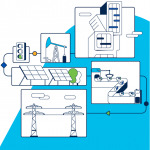The transportation industry is going through a resurgence. Everything is increasing: traffic, congestion, the percentage of connected cars on the road – even the number of pedestrians. Transportation agencies need to respond to these changes to improve public safety and make travel easier for drivers and passerby. Fortunately, the internet of things (IoT) can play a pivotal role in Vision Zero, a multi-national road traffic safety project aiming to put a stop to fatalities and serious injuries involving road traffic.
Today, fewer than 3,000 jurisdictions across the United States perform traffic management from physical centers. Less than 30 percent of signalized intersections are “connected” via dedicated, private networks. While intersections with advanced detection capture significant amounts of data, it’s not stored, aggregated, shared, or analyzed. It’s difficult to conduct remote monitoring and optimization when cities have limited connectivity, heterogeneous environments, and a lack of software tools. As a result, data is generally stranded at each intersection, where it offers little or no value.
Due to the advances in vehicle communications technologies, cities and roadway operators are rapidly deploying improved connectivity to the roadside. The goal is to have 100 percent of signalized intersections interconnected and cloud ready. Data collected at intersections with advanced detection will be seamlessly stored, aggregated, analyzed, shared, and processed. The availability of pervasive connectivity, data standards, and advanced software apps will enable remote monitoring and optimization. As a result, traffic management will be performed from cloud-based centers, creating significant operating efficiencies.
The future of traffic management is starting today, in cities like Las Vegas. If you’ve ever been to Vegas, you know how congested the streets can get — both with people and vehicles. To make matters more complicated, pedestrians aren’t always in a sound state of mind, so drivers have to be extra careful to watch for those crossing the street in random places. The city needed a better understanding of pedestrian incidents to be able to proactively prevent them – that’s where Cisco came in.
As part of our connected intersection deployment, Cisco led a proof of concept for connected vehicle technology in which we leveraged the vehicle as a sensor. Las Vegas was able to listen to vehicles with connected technology to learn about emergency breaking conditions and traction control issues. This capability proved especially valuable during inclement weather: the city was able to improve safety conditions by identifying where vehicles were having traction control issues (i.e. hydroplaning). Going forward the city will be able to proactively respond by either fixing the conditions for future storms or sending out rapid response teams during an event. Not only was Las Vegas able to aggregate data, they now have the power to act on it.
Las Vegas is just one use case for connected intersections. The insights obtained from sensored traffic signals can be used to maintain and adapt operational management. Traffic control centers can proactively respond to changing traffic conditions and outages, improve traffic safety and signal performance, and enhance the citizen experience — all while reducing costs by operating in the cloud.
At Cisco, we’re bringing insights to traffic management centers and traffic operators so they can help reduce and respond to delays in real time by using analytics and signal performance measurement. To learn more, watch our webinar: Improve Safety and Simplify Traffic Operations with Modern Connected Intersections.

CONNECT WITH US